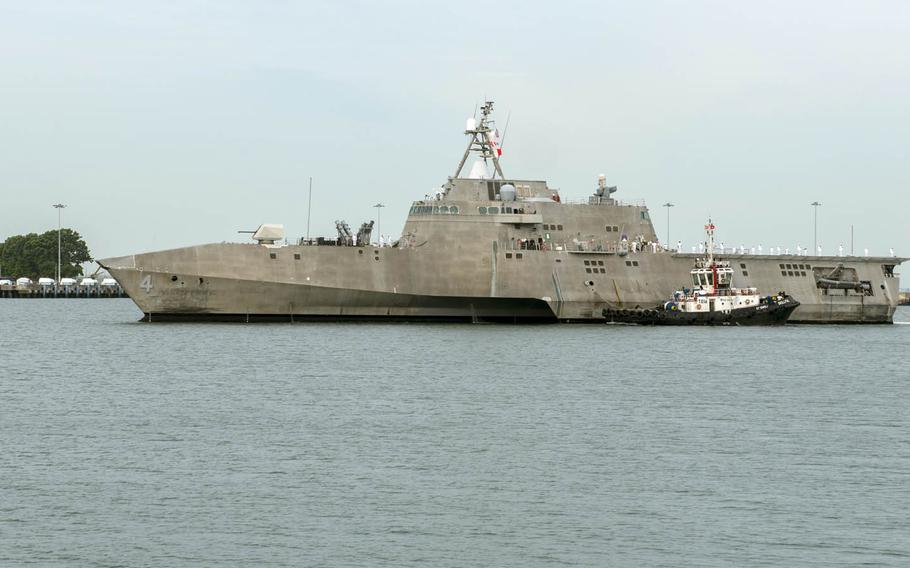
The USS Coronado arrives at Changi Naval Base, Singapore, for a rotational deployment, Sunday, Oct. 16, 2016. The Coronado is the first trimaran-hulled variant of the fast, shallow-draft ships to deploy to Southeast Asia on a two-crew, rotational basis. (Joshua Fulton/U.S. Navy photo)
YOKOSUKA NAVAL BASE, Japan — The littoral combat ship USS Coronado arrived in Singapore on Sunday as Navy officials continue to express confidence in the ship program amid concerns.
The Coronado is the first trimaran-hulled variant of the fast, shallow-draft ships to deploy to Southeast Asia on a two-crew, rotational basis.
“There’s a huge amount of demand for the littoral combat ship by every nation out here in terms of exercise and integration,” Rear Adm. Don Gabrielson, Commander of Task Force 73, told reporters Sunday according to Bloomberg News.
Coronado takes the place of the USS Fort Worth, which returned to its San Diego homeport Oct. 7 after 23 months away.
Damage to Fort Worth’s propulsion gears while in port in January delayed the ship’s return after what was scheduled to be a 16-month deployment.
Coronado’s deployment is expected to last 14-16 months, though that could change based on operational requirements, CTF-73 spokesman Lt. Cmdr. Arlo Abrahamson said Monday.
Coronado’s design allows for a larger flight deck than Fort Worth, giving it the ability to deploy dual MQ-8B Fire Scout unmanned helicopters.
The ship also has an embarked MH-60S Seahawk helicopter, which is a first for an LCS deployed to Singapore.
Coronado, an Independence-class LCS variant, also has a larger fuel capacity than the Freedom-class littoral ships, according to a Navy statement.
Coronado’s surface-warfare package includes two boarding teams, two rigid-hull inflatable boats, two 30mm machine guns and the helicopters.
It’s a design meant for taking on swarms of smaller craft, particularly in nearshore waters where destroyers can’t safely navigate.
However, the LCS was also meant to replace the service’s aging mine countermeasure ships and take on an anti-submarine role.
Testing for the delayed anti-submarine package is now estimated to complete developmental testing in 2018, according to a June Congressional Research Service report.
The original mine countermeasure package included a remote minehunting system with “significant reliability issues,” according to the CRS report, leaving the Navy to look for other technologies before adding a minehunter capability to the littoral ships.
Concerns in Congress and from some in the Pentagon over the ship’s survivability led to changes in the LCS program that will build the final 16 of the 40-ship program as heavier frigates.
The frigates won’t be relied upon for mine countermeasures but are expected to have more built-in defenses for submarines and aircraft, CRS said.
In the meantime, the Navy is moving forward with LCS deployments in its current configuration. The service plans to have four LCS in Southeast Asia by 2018.
The Navy has prioritized security in the South China Sea, where about $1.2 trillion in U.S. trade and $5 trillion in global trade transits annually.
China’s claims on about 90 percent of the South China Sea, including areas considered by the U.S. and the Permanent Court of Arbitration in The Hague to be international waters, have stoked tensions in the region.
The LCS deployment isn’t a specific message to China, Gabrielson said, according to the Bloomberg report.
“It’s not a message to anyone other than what is going on in this part of the world matters to the whole world,” he said.